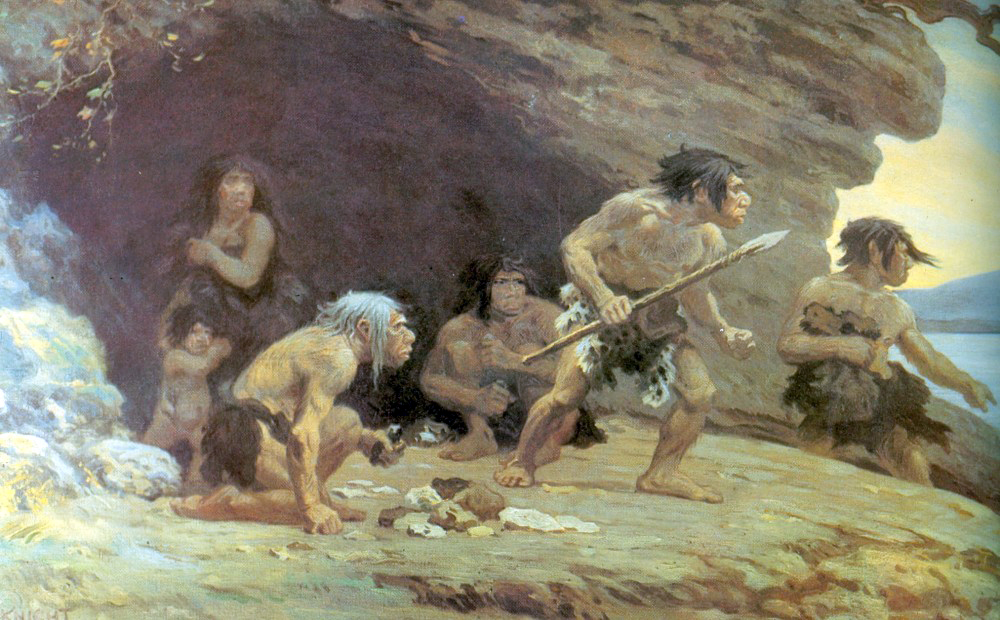
I learned this today. Neanderthals were named after the place where they were found. The Neander Valley in modern Germany. “Thal” means valley in German.
The earliest Neanderthal bones found were in 1829 in Belgium. A Dutch naturalist called Philippe-Charles Schmerling found a skull, but he thought it was a fossil of a human skull and he thought no more of it. Then, in 1848, a second skull was found on the island of Gibraltor, but that was also thought to be a human skull.
It is easy to wonder how they could miss something so obvious, but there was no reason for them to think that there used to be a subspecies of humans. We only know that because of the evidence that started to accumulate from this point on.
In 1856, workers from a lime quarry in Neandertal dug up some bones. They found a cranium, thigh bones, right arm, parts of a left arm, a right shoulder blade and some rib pieces. They thought the bones belonged to a bear. Luckily, rather than throw them away, they showed them to a local schoolteacher. By another stroke of good luck, that teacher happened to be Johann Carl Fuhlrott, a paleoanthropologist who was teaching at the local school. He recognized that they were not bear bones, but very old human bones. However, he also recognized that they were different to normal fossilized human bones. Believing that they were the bones of an ancient human race, he took them to the University of Bonn and showed them to Professor Herman Schaaffhausen, professor of anatomy. They knew that the bones were those of a distinct human species and they announced their findings in 1857.
And, nobody believed them. The idea that there was another species of human went against the teachings of the Bible. Then, in 1859, Darwin’s “On The Origin Of Species” was published and academic thinking began to change. There was an argument that Neanderthals were us before we evolved to be civilized. There was still a lot of argument against this find proving the existence of a subspecies of human.
In 1864, the name Homo neanderthalensis was given to the species. “Homo” is the human species (we are homo sapiens), and “neanderthalensis” after the place where the bones were found. The Neander Valley (Neander Thal).
Neanderthals evolved from an ancestor that they share with us, Homo heidelbergensis, about 400,000 years ago. They existed until about 40,000 years ago when they went extinct. The reason for their extinction is unknown but some of the theories are they lost out to the superior technology of humans; climate change made an environment they couldn’t survive in; disease passed from early humans to them; a low population requiring interbreeding which resulted in successive birth defects.
By the end of the 20th century, other Neanderthal remains had been found and people could no longer argue against the evidence. Yet, there was an unwillingness to credit the Neanderthals with the same intelligence as us. They had died out, so we were obviously smarter, the thinking went. The French paleontologist, Marcellin Boule, write several books about them and he explained that they were slouching, ape-like, and only distantly related to modern humans. He said that they were violent, unintelligent, primitives, and this image stayed with the Neanderthal for a long time. In fact, a lot of people probably still think this.
It took until about 1950 for the scientific community to change the way they thought about Neanderthals. It is now known that they were hunter gathers but had the ability to cook and prepare food. They painted cave walls and they wore jewelry made from bones and shells. Bone flute pieces have been found showing they had music. They could work stone to make tools. They used bark tar as an adhesive. They made clothes and there is evidence that they made boats. They were able to medically treat broken bones and use medicinal plants. They probably had language, but there is no way of knowing how much.
This is a far cry from the slouching, violent neanderthal that was described in the late 1800s.
So, neanderthal bones were found in the Neander Valley (thal) in Germany in 1857. A local teacher recognized that they were a separate species of human, but it took many years for people to agree. The new species of human was named after where it was found. Neanderthal. And this is what I learned today.
Sources
https://en.wikipedia.org/wiki/Neanderthal
https://en.wikipedia.org/wiki/Johann_Carl_Fuhlrott
https://humanorigins.si.edu/evidence/human-fossils/species/homo-neanderthalensis
https://www.nhm.ac.uk/discover/who-were-the-neanderthals.html
https://www.smithsonianmag.com/science-nature/rethinking-neanderthals-83341003/
https://www.nhm.ac.uk/discover/who-were-the-neanderthals.html
